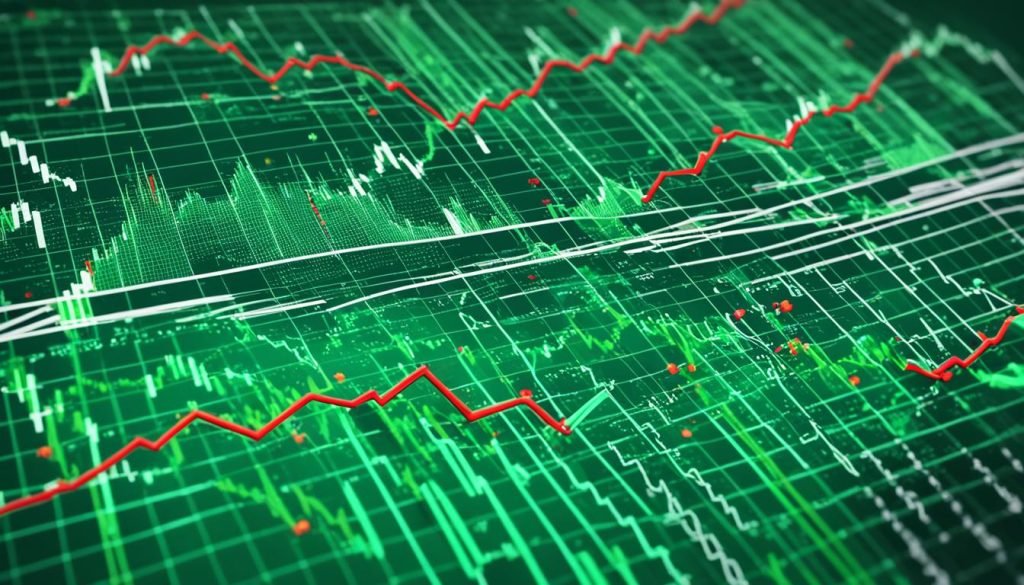Welcome to the exciting world of Forex trading. Here, currencies are always changing. People can earn a lot of money, and financial freedom is possible. Are you a newbie ready to start in the Forex markets? Or maybe you’re a pro wanting to boost your skills. It’s crucial to have solid strategies for success. In this guide, you’ll learn about strategies that make currency market trading easier and more confident.
Knowing and using these strategies makes you a stronger trader. You can spot good chances and handle risks better. We’ll teach you about key strategies, from reading charts to making smart risk plans. These will boost your trading and help you make more profit.
Key Takeaways:
- Forex trading needs good strategies to do well in the markets.
- Learning about charts, data, feelings in the market, and trade signs helps make better choices.
- It’s important to manage risks to keep your money safe. This includes using stop-loss orders and careful use of leverage.
- Also, picking the best Forex broker is key. Look at their fees, trading platforms, and customer help.
- Never stop learning and getting better at Forex trading for long-term success.
Getting Started in Forex Trading: Laying the Foundation
Before diving into Forex trading, understanding the basics is key. By starting on a solid foundation, beginners can trade with confidence.
The Forex Market: An Introduction
The Forex market is where currencies are traded. It is the world’s largest financial market, with trillions traded daily. This market allows beginners to make money from currency price changes.
Essential Tools and Platforms
Having reliable tools and platforms is crucial for beginners. Look for platforms that are easy to use and provide up-to-date market data and tools for analysis. MetaTrader and cTrader are popular choices for their beginner-friendly features.
Understanding Basic Forex Concepts
Learning the essential Forex concepts is important before trading. This includes knowing about currency pairs, pip values, and how lot sizes work. Take time to understand these basics, as they’re fundamental to Forex trading.
Setting Up a Demo Account
Starting with a demo account is a good idea for beginners. It lets you trade with play money, offering a risk-free way to test strategies. Gaining practical experience this way can be very helpful.
Developing a Trading Plan
Having a trading plan is essential for success in Forex. It specifies your goals, risk tolerance, trading style, and strategies. A solid plan keeps you disciplined, reducing the chance of making emotional decisions.
Continuous Education: Key to Success
Learning is constant in Forex trading. Keep up with market trends, economic news, and new strategies. Webinars, reading articles, and joining trading communities can all help expand your knowledge.
Forex Trading Basics
| Concept | Description |
|---|---|
| Currency Pair | A pair of currencies used to execute Forex trades, such as EUR/USD or GBP/JPY. |
| Pip | The smallest unit of measurement in Forex trading, representing the smallest price movement. |
| Lot Size | The standardized amount of currency to be traded in a single transaction. |
| Bid/Ask Price | The bid price is the price at which traders can sell a currency, while the ask price is the price at which traders can buy a currency. |
| Spread | The difference between the bid and ask price, representing the transaction cost for traders. |
Analyzing the Market: Key Techniques for Forex Traders
Analyzing the market is a key part of Forex trading. Traders use tools like technical analysis, fundamental analysis, sentiment analysis, and trading signals to guide their decisions.
Technical analysis looks at price movements and indicators. This helps traders find trends, support, resistance, and where to enter or exit a trade. By looking at past price movements, traders get hints about what could happen.
Fundamental analysis checks economic news and events. It looks at how big decisions, like those from central banks, and politics, might change currency values. Understanding these can help predict market changes.
Sentiment analysis checks the market’s feelings. Traders watch social media, news, and special indicators to see if people are mostly positive or negative about the market. This can help traders make choices that match the current market vibe.
Trading signals are tips on when to buy or sell. Traders look at services, their own systems, or use special indicators to get these signals. Using these signals can help traders spot good opportunities.
Using all these methods together gives a full picture of the market. Technical analysis spots trends, fundamental analysis digs into reasons, sentiment analysis feels the market’s pulse, and trading signals hint at moves. But remember, no single method is a sure win. Smart traders use a mix of tools and trust their own judgment.

| Technique | Key Features |
|---|---|
| Technical Analysis | – Study price patterns and indicators – Identify trends and entry/exit points – Use historical data for analysis |
| Fundamental Analysis | – Analyze economic indicators and news events – Consider political and economic factors – Understand underlying market forces |
| Sentiment Analysis | – Gauge market mood and investor sentiment – Monitor social media and news sentiment indicators – Align strategies with market sentiment |
| Trading Signals | – Provide insights into potential entry/exit points – Use predefined criteria for buy/sell signals – Incorporate signals into analysis for trade setups |
Risk Management Strategies: Protecting Your Investments
Risk management is key in successful forex trading. Effective strategies help keep your investments safe. They also lower the risk of losing money. We’ll look at important risk management practices, like stop-loss orders and managing leverage, in this section.
Establishing Risk Tolerance
Before you start trading, you must know how much risk you are okay with. This is your risk tolerance level. Knowing this helps you make smart choices. It also stops you from risking too much and potentially losing a lot of money.
Utilizing Stop-Loss Orders
Stop-loss orders are a great way to manage risk. You set a point where your trade will stop if it’s not going well. This helps prevent big losses. Using stop-loss orders means your investments are safer and you won’t lose too much money on a single trade.
Managing Leverage
Managing leverage well is very important. Leverage can make your profits bigger but also your losses. It’s risky. So, think hard about how much leverage you use. The right leverage helps you balance risk and reward better.
Diversifying Trading Portfolios
Spreading your money over different currency pairs is diversification. It lowers the risk from one trade going bad. This means you might not lose as much money. A mix of different currencies in your portfolio is a smart move for lowering overall risk.

Continuous Monitoring and Evaluation
Keeping an eye on your trades is as important as setting up risk management in the first place. It lets you spot where you can do better. Knowing what you’re good and not so good at helps you adjust your strategies.
Using these risk management strategies, like knowing your risk tolerance and diversifying, helps keep your investments safe. And keeping an eye on your trades keeps you on track in the changing forex world. With the right approach, you can tackle the forex market with confidence.
Choosing the Right Forex Broker: What You Need to Know
Selecting the right forex broker is critical for trading success. It’s vital to look at many factors. This includes fees, the trading platform, and customer service. Each is important for finding a broker you can trust and rely on.
Researching Forex Brokers
When picking a broker, research is key. Find brokers with strong reputations and good reviews. Also, check their licensing and history. This shows if they’re respected in the forex world.
Understanding Fees and Spreads
Know a broker’s fee structure before you decide. This includes spreads, commissions, and extra costs. Compare fees to see if they fit your budget and trading style.
Assessing Platform and Tool Availability
The trading platform is where you’ll make your moves. It should meet your needs and be easy to use. Make sure it has tools for technical analysis and fast market data. Some brokers offer educational tools too, helping you trade better.
Evaluating Customer Support and Education Resources
Good customer support is key. Find a broker that’s quick and useful when you need help. They should offer education, like webinars and analysis, too. This can help you improve as a trader.
Checking Execution Speed and Slippage
Execution speed and slippage matter a lot. Choose a broker with great technology. This helps ensure your trades happen quickly and at the right prices. Avoid brokers known for slippage to prevent unexpected losses.
When you account for all these points, you’re on the right track to choosing a good broker. Remember, picking the right one is a key step to succeeding in forex trading.
Continuous Learning and Improvement in Forex Trading
Learning and getting better in Forex trading is key. The world’s financial markets always change. Being up-to-date and improving trading skills help a lot. Here’s how you can do that:
- Stay updated on global economic news: Keep track of economic events and policy decisions. This keeps you ahead on what could affect currency values. Use trusted news sources, economic calendars, and expert opinions. They help understand market trends better.
- Utilize educational resources: The internet has a lot to offer for learning more about Forex. Read articles, watch tutorials, and join online classes. Look for resources from known trading educators and brokers. This info can give you new strategies and ways to look at the market.
- Join online Forex communities: Be part of Forex discussion groups and forums online. Talking to other traders is a great way to gain knowledge. You can get ideas, advice, and share your thoughts on the market with them.
- Seek guidance from experienced traders: Find and connect with seasoned traders who are willing to help. They can pass on tips, talk about their experiences, and warn you against common mistakes. This mentorship can really speed up your learning process.
Education, keeping current, and networking in the Forex community are vital for growth. Welcome the journey of learning and always aim to better yourself in Forex trading.
“Continuous learning is the key to mastering Forex trading. Stay informed, never stop learning, and embrace the wisdom of experienced traders.”
Forex Trading Education Comparison
| Platform | Course Options | Accessibility | Interactive Elements |
|---|---|---|---|
| Forex University | Beginner to advanced courses, live webinars | Accessible from any device at any time | Interactive quizzes, trading simulators |
| Trader’s Academy | Comprehensive video library, eBooks | Available on desktop and mobile | Discussion forums, Q&A sessions |
| Forex Mastery | Self-paced learning modules, one-on-one coaching | 24/7 access from any location | Live trading sessions, case studies |
Conclusion
Forex trading is thrilling for all – new and old traders – in the global markets. Understanding the Forex markets keeps you on track. It’s all about having good strategies and handling risks.
Learning and adapting are key for doing well in Forex over time. So, start your journey today. Discover how you can achieve financial independence through Forex.
FAQ
What are some effective Forex trading strategies?
How can beginners get started in Forex trading?
How can traders analyze the market in Forex trading?
Why is risk management crucial in Forex trading?
How should traders choose the right Forex broker?
How can traders continuously learn and improve in Forex trading?
What should beginners know about Forex trading?
Source Links
- https://www.linkedin.com/pulse/beginners-guide-forex-trading-navigating-currency-markets-marware-klbuf
- https://www.linkedin.com/pulse/forex-trading-navigating-currency-markets-confidence-michael-weare-ibmwe
- https://forexinflux.com/trading-strategies/327-navigating-currency-markets-an-essential-guide-to-forex-strategies.html




